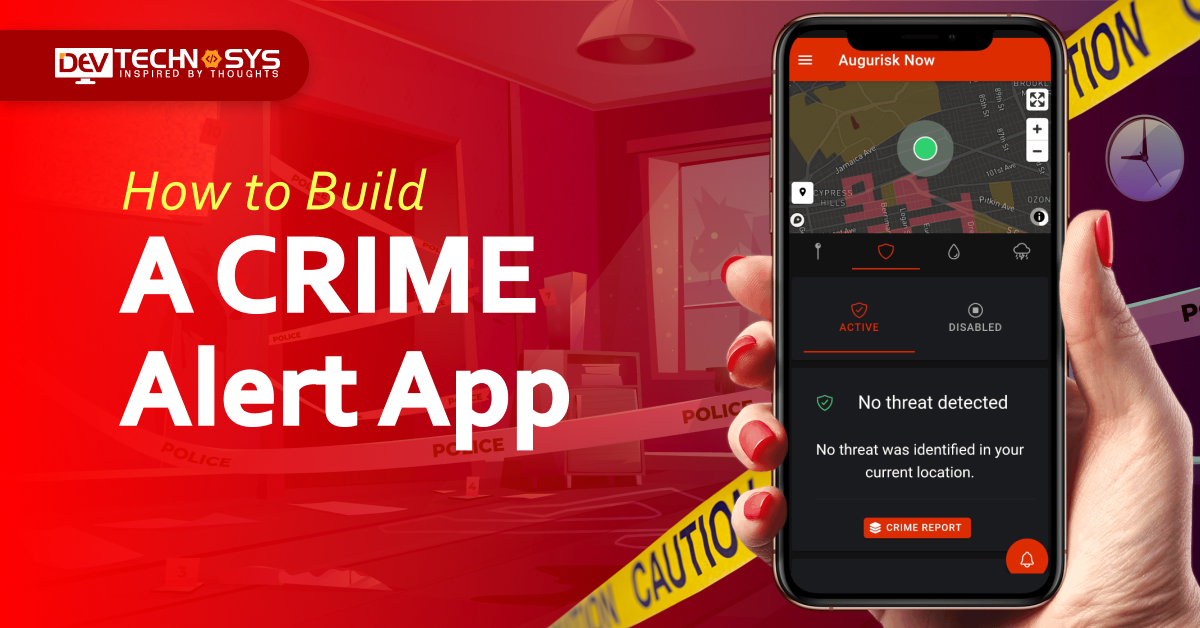In an era where crimes are increasing at a rapid rate, staying informed is crucial to protect yourself from potential risks. But with the dominance of crimes like kidnappings, robberies, or murders we see on news channels on a daily basis, how do we stay informed and protected?
This is where crime alert smartphone applications come in. People are paying great attention to personal security, which is driving the growth of the crime alert app development industry. Businesses seeking to capitalize on this rising demand are reaching out to companies that build crime alert apps to develop their own crime alert apps, aiming to boost their business.
These applications offer an intuitive solution by leveraging the latest industry trends, new technologies, and expertise to help people and their loved ones stay alert and protected from various criminal activities, including theft, pickpocketing, robbery, abduction, shootings, and other forms of violence.
If you are a business wanting to enter the crime alert app development industry, then you’ve arrived at the right place. In this blog, we will provide valuable insights on how to build a crime alert app, guide you through the app development process, and explore the fundamental features and more interesting factors of developing a crime alert app.
What is an Crime Alert App?
An emergency alert app is a digital tool created specifically for sending important notifications and real-time alerts to people or companies during a crisis. With the help of these crime alert sending apps, users can send alerts in distressing situations for immediate assistance.
Therefore, these apps use high-end technologies such as GPS, push notifications, and Artificial intelligence to transfer data concerning natural disasters, accidents, medical emergencies, and security threats.
The main reason to create a crime alert app is to promote swift communication by providing essential information to users. This may include the nature of the emergency, affected sites or locations, safety instructions, and emergency contact information.
Developing the best criminal alert apps helps deliver enterprise notification features and a panic button, directly ensuring personal safety on the mobile phone.
Market overview of Crime Alert App Development
https://www.verifiedmarketreports.com/images/02-24/emergency-alert-app-market.webp
- The global mass notification system market shows potential to reach USD 23.8 billion in 2024 to USD 65.1 billion by the end of 2029, at a CAGR of 22.3% during the forecast period.
- The emergency notification software market is expected to reach USD 10 billion by 2030.
- The market of emergency and disaster response is expected to reach USD 177.70 billion in 2025.
- The emergency warning light market is valued at USD 2.5 Billion in 2024 and is expected to rise at USD 4.8 Billion by the year
- The Emergency alert app market is expected to reach USD 8.2 Billion by the year 2033.
How Does an Crime Alert App Work?
Before you decide to build a crime alert app, then you must know how these applications work in the first place. The below-mentioned points explore the functioning of the app, allowing the app to effectively detect and respond during emergencies:
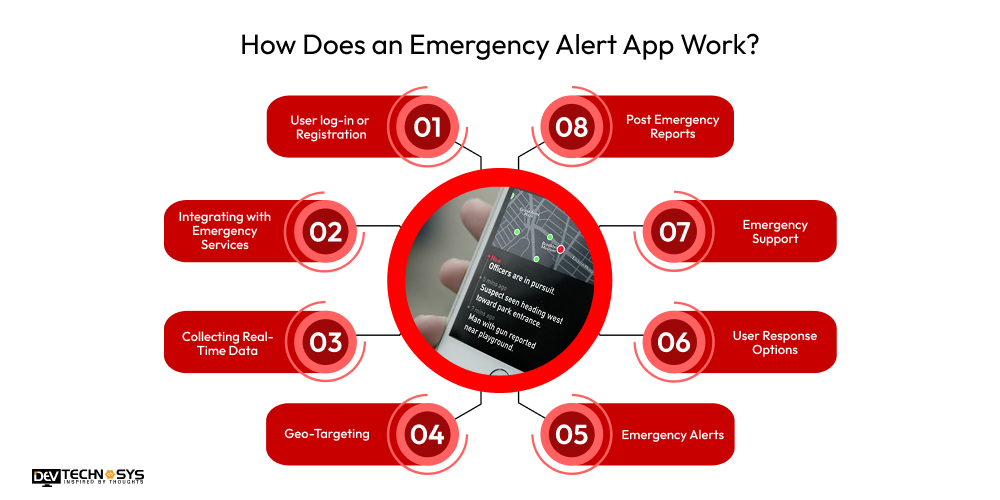
1. User log-in or Registration
Users can generate an account by entering their personal details and providing emergency contact information. They can also enable permissions like location access and notification to ensure accurate and timely alerts.
2. Integrating with Emergency Services
Applications like these stay in contact with government agencies, whether they are stations or local authorities, for verified data and to ensure credible and accurate emergency alerts.
3. Collecting Real-Time Data
Not only that, but Cime alert apps also monitor sources like weather forecasts, user information, and reports, and unaltered geolocation. However, AI-based systems analyze patterns to foresee threats and send timely alerts.
4. Geo-Targeting and personalization
The app sends real-time alerts and notifications based on the user’s current location and emergency preferences. This feature ensures that users get only relevant and actionable notifications.
5. Emergency Alerts
All important alerts are sent to users through notifications, email with detailed instructions, and SMS. Users can provide important details like emergency type and location in the following steps.
6. User Response Options
It allows users to respond by sending SOS signals, reporting any incident, and sharing the location *(either theirs or of incidents). The app contains interactive options like “I’m Safe,” which enables two-way communication.
7. Emergency Support and Guidance
The crime alert app for alerting crimes offers strategies for evacuation, tips for giving first aid, and information concerning nearby emergency resources. This ensures that users receive the much-needed help in times of emergencies or crises.
8. Post Emergency Reports
For review purposes, they keep a log of alerts and user actions. Therefore, the data provides users and authorities with a review and analysis of the events and response strategies.
Why Should Businesses Invest in Crime Alert App Development?
Investing in the development of a crime alert is more than just being socially conscious and responsible. It also creates numerous opportunities for business, community, and technical benefits:
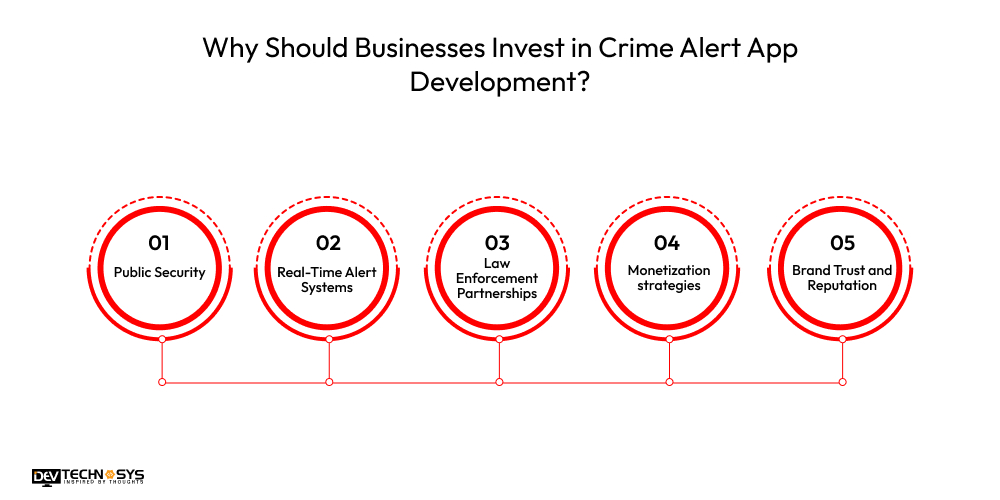
1. Public Security and Social Impact
Crime alert applications give users the freedom to report crimes, receive real-time updates regarding safety, creating safer surroundings, localities, and cities. Businesses that are invested in building crime-learned applications contribute to social wellness and civic engagement.
2. Increasing Demand of Real-Time Alert Systems
With the growing tension of public security and safety, urging people to depend on tools and platforms that provide instant alerts on crimes or safety concerns nearby, suspicious activities, and emergencies, creating a growing market for these solutions.
3. Government and Law Enforcement Partnerships
Crime alert apps can employ monetization techniques like collaborating with government agencies, police departments, and NGOs.It enables them to coordinate better and raise funding opportunities.
4. Monetization strategies
It is a great decision to develop a crime alert app as it has immense earning potential. The strategies of monetization may include location-based alert filters, community chat zones, or syncing contacts for emergencies.
5. Brand Trust and Reputation
According to a top mobile app development company, making a crime alert application that encourages personal safety can boost your brand image, foster community trust, and align with CSR goals.
Top 10 Crime Alert Apps to Explore in 2025?
| App Name | Launch Year | Ratings (iOS/Android) | Platform Availability | Focus Area |
| Citizen | 2017 | 4.8 / 4.6 | iOS, Android | Real-time crime alerts, live incident tracking |
| Moonlight | 2013 | 4.8 / 4.7 | iOS, Android | Silent emergency alerts, automatic dispatch |
| Life360 | 2008 | 4.8 / 4.5 | iOS, Android | Location sharing, crime reports, family safety |
| Ring – Neighbors | 2018 | 4.7 / 4.4 | iOS, Android | Neighborhood crime sharing and safety notifications |
| Flock Safety (App) | 2017 | 4.0 / 3.8 | iOS, Android | Crime alerts linked with license plate cameras |
| RedZone Map | 2014 | 3.9 / 3.7 | iOS, Android | Crime hotspots and navigation through safe routes |
| My Safetipin | 2013 | 4.2 / 4.3 | iOS, Android | Safety score for areas, incident reporting |
| One Scream | 2018 | 4.2 / 4.1 | iOS, Android | Voice-activated distress alerts (e.g., scream detection) |
| Watch Over Me | 2013 | 4.1 / 4.0 | iOS, Android | Location tracking, emergency alerts, automatic video |
| bSafe | 2011 | 4.3 / 4.2 | iOS, Android | SOS button, live streaming during danger |
Impact of AI on Crime Alert App Development
Crime alters apps have undergone a complete transformation with the involvement of AI. People now view them as a proactive and intelligent platform instead of reactive notifications.
They are now platforms responsible for personal safety. In addition to providing predictive analysis and real-time threat detection, these apps are able to accurately identify high-crime regions.
Furthermore, by removing false crime alerts while providing highly personalized safety tips tailored according to individual users, AI significantly enhances data reliability.
AI provides immediate, useful information that refined integration with IoT and smart city infrastructure, making communities safer by facilitating quicker, better-coordinated emergency responses.
Types of Applications in the Crime Alert Industry
The crime alert industry is hungry for innovation. There is an abundance of rising technologies and opportunities for addressing emerging safety needs. Some of the top crime alert app development ideas include:
- Incident Prediction Apps: The usage of AI and advanced technologies analyzes historical data of crimes and predicts the areas or locations where the chances of crimes are extremely high. It enables users to take proactive measures for safety.
- Community Policing Platforms: Apps that connect local law enforcement with community members for better collaboration and faster resolutions. Apps that connect local law enforcement laws
- Emergency Action Guides: Interactive apps that provide step-by-step guidance for users during crises like break-ins or active shooter situations.
- IoT-Integrated Crime Detection: Apps that sync with IoT devices like smart cameras or doorbell sensors to provide real-time updates and alerts.
- Anonymous Witness Platforms: Solutions that boost safe and unknown crime reporting to reduce uncertainty and improve community participation.
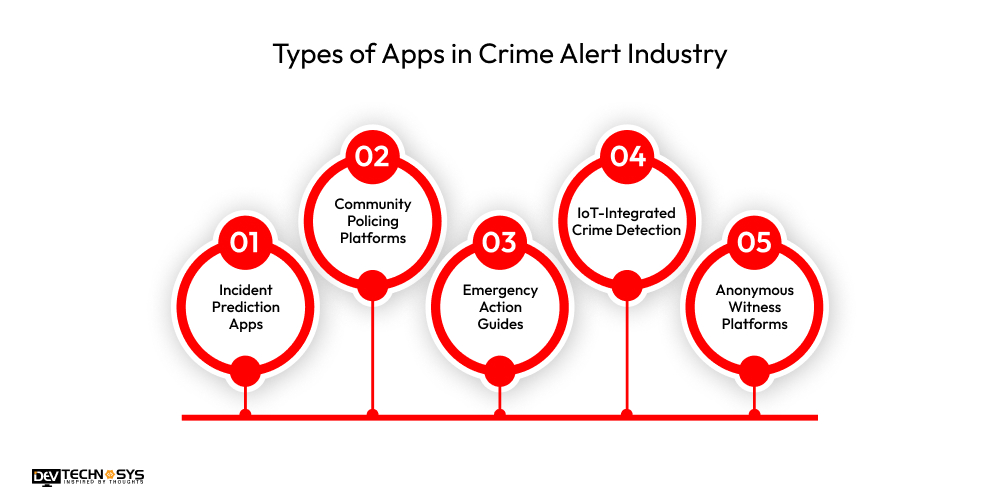
Features to Incorporate in a Crime Alert Application
In the below section, we have mentioned some of the key features that developers need to incorporate in a crime alert app. Take a look:
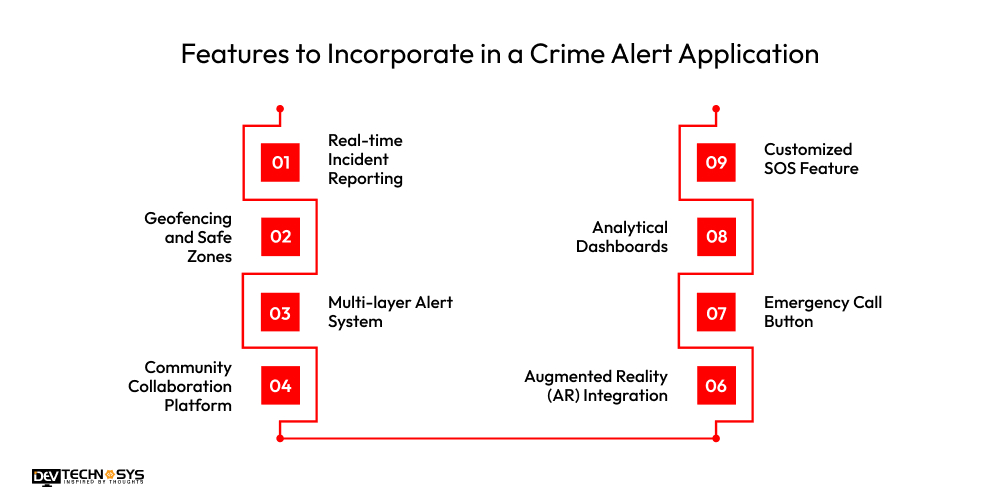
1. Real-time Incident Reporting
Crime alert mobile app development requires features like real-time incident reporting that allow users to instantly report crimes, suspicious behavior, or emergencies.
This empowers communities and allows law enforcement agencies to act swiftly. Fast reporting can prevent incidents from escalating and helps in building a trusted app ecosystem.
2. Geofencing and Safe Zones
This crime alert mobile app development feature allows users to set specific geographic areas like their home, office, or child’s school as safe zones. Whenever a crime is reported near these zones, users receive alerts. Geofencing also enhances personalized notifications based on the user’s movement and current location.
3. Multi-layer Alert System
While building an emergency alert app, ensure the addition of different types of alerts. it may include visual warnings, audio signals, and more. offer customized settings so users can select alert format and urgency level that best fits the requirements and lifestyle.
4. Community Collaboration Platform
When you decide to make a crime alert app, ensure the addition of in-app community features to bring more user engagement. This feature may include forums, chats, or neighbourhood updates. It is a collaborative platform that ensures trust, allows sharing of information, and gives a sense of collective safety.
5. Augmented Reality (AR) Integration
Developers who create a crime alert app add this feature to help users. Through this, users can visualize the live crime data overlaid on their smartphone cameras. This feature is extremely useful while travelling alone at night or navigating way in unknown areas.
Interested in a chatbot demo, pricing, or more info? Fill out the form our expert will contact you shortly.
-
Chatbot Demo
-
Cost to Develop an app
-
Industry Report
-
Case Study
6. Emergency Call Button
If you want to make a crime alert app, then include an emergency call button feature in your app. This feature is important in times of crises or emergency situations. it reduces the time of users in searching for help during such situations.
7. Analytical Dashboards and Crime Trends
This feature sends visual information through graphs, heatmaps, and statistics. The data sent through these apps helps users understand crime-prone zones, recent patterns, and time-based trends, empowering them to take safety precautions.
8. Customized SOS Feature
This feature is crucial to develop a crime alert app as it enables users to send quick SOS alerts with GPS location. This feature is lifesaving in situations where calling or texting isn’t possible.
Steps to Build a Crime Alert App
Here are the important steps you should know about, in order to create a crime alert app. Let’s dive in:
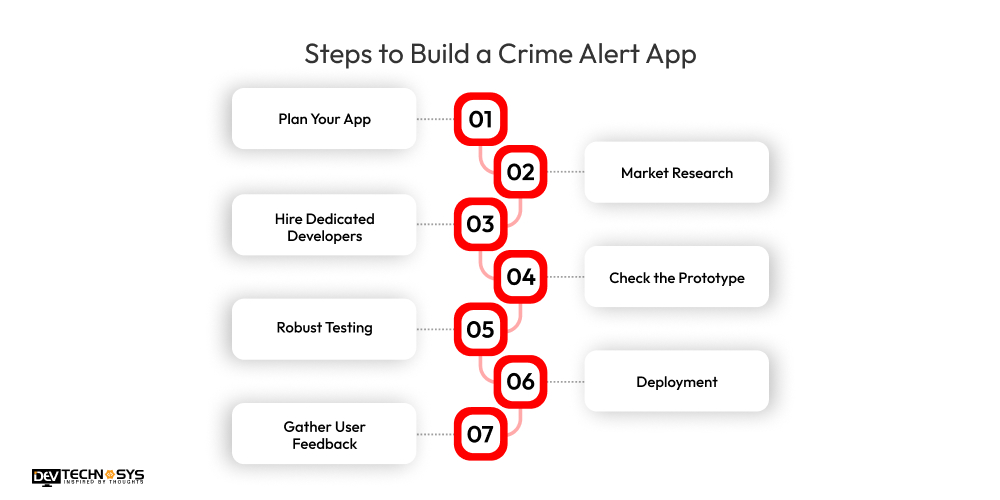
1. Plan Your App and Build a Vision
Undoubtedly, the iOS or Android app development project needs specific planning and vision to focus on. So, plan efficiently for the application you want to create.
It is crucial to know if the app you are making is strictly a criminal alert or serves other purposes as well. See beyond criminal alert app development and make the final decision. You also have to ensure whether the platform you want to choose to build a criminal alert app.
| Important Questions |
| Why is having a clear vision important in crime alert app development? |
| What should I consider when choosing the platform for my app? |
| Should the app focus solely on crime alerts or include other safety features? |
2. Go Deep in Market Research
The next step is to conduct in-depth market research. It is advisable to know crucial things about the industry if you want to develop an app. Make sure to learn about other pre-existing apps in the market.
Moreover, carry provides a list of features you need to provide in yours. Make sure to learn about the competitive advantages it brings so you can use it to your advantage. However, the performance of different apps is based on their unique abilities.
| Important Questions |
| Why is market research essential for a crime alert app? |
| How do I analyze competing crime alert apps? |
| What competitive advantages should I aim for? |
3. Hire Dedicated Developers
The dedicated developers’ team plays an important role in crime alert app development. Once you hire dedicated developers, they convert your unique app ideas into high-performing applications.
State all your requirements with the vision you hold about the app, features you desire, etc., and always ensure the developers you select work with you as a partner and be as invested in the project as you are.
| Important Questions |
| Why hire a dedicated development team instead of freelancers? |
| What should I discuss with developers before starting the project? |
| How do I choose the right development team? |
4. Demand and Check the Prototype
A prototype works as a rough structure of the crime alert app. through the prototype, you can get a general idea of the user interface included in the app, and features it will incorporate. Make sure the prototype aligns with the expectations.
Take time in ordering to analyze the prototype, after getting approval for your prototype, it might cost you additional time and expense to make any changes. So, it is crucial to ask for and check the prototype to build a criminal alert app.
| Important Questions |
| What is a prototype and why is it important? |
| What should I evaluate in the prototype? |
| Can changes be made after prototype approval? |
5. Thoroughly Test the Developed App
After the development phase is complete, it’s time to rigorously test your crime alert app. Testing is a crucial phase as it helps in finding out any bug, glitches, or issues with performance.
Both functional and usability testing is crucial to ensure the app operates smoothly and and stands true to user expectations. Look for top Android app developers for hire who would provide testing tools and techniques to perform robust quality assurance.
| Important Questions |
| What types of testing should be done? |
| Who performs the testing—developers or a separate team? |
| How do I ensure my app is bug-free? |
6. Deploy and Market the App Strategically
After your crime alert app is developed and gets ‘ok’ from the testing team, it’s time to deploy it on the app store, Google Play Store for Android, or the Apple Store for iOS. Just follow the rules and guidelines specific to the platform for deployment and ensure your app complies with all regulations and policies required.
Forming partnerships in enforcement agencies, NGOs and other community organizations, or other relevant entities to raise visibility and reliability. A well-executed marketing plan is essential to a broader audience and encourages downloads.
| Important Questions |
| How do I launch the app on app stores? |
| What marketing strategies work best for a crime alert app? |
| Why is strategic marketing crucial? |
7. Gather User Feedback and Implement Updates
This is the step you need to follow to make a crime alert app. In this step, development providers actively seek feedback from users through reviews and surveys and hold direct communication. Next, they analyze this feedback provided by users to identify areas that need fixing or additional features that the user wants in the app.
Implement regular updates of features and functions to address user concerns, improve app performance, and stay ahead of evolving safety and protection needs.
| Important Questions |
| How can I collect feedback from users? |
| What should I do with the feedback? |
| How often should I update the app? |
Cost To Build a Crime Alert App
The cost to build a crime alert app varies significantly depending on complexity and features. A basic crime alert app with SOS functionality and basic location tracking can range from $10,000 to $18,000, while the cost to build a crime alert is a complex app with advanced features, real-time alerts, integration with emergency services, and can be around $10,000 to $20,000.
For highly refined Android or iPhone App Development, with AI-powered risk prediction and other advanced features, the cost to develop a crime alert app can go from $12,000 to $30,000 or even higher.
| App type | Estimated Cost (USD) | Estimated Development Time |
| Basic | $8,000 – $12,000 | 4 – 6 weeks |
| Moderate | $12,000 – $20,000 | 6 – 10 weeks |
| Advanced | $20,000 – $30,000 | 10 – 14 weeks |
Factors Affecting the Cost to Build a Crime Alert App
Here are some of the factors that can affect the cost of building a crime alert app:

1. App Complexity & Features
This is among the most significant factors that influence the Cost to Build a Crime Alert App to a great extent. A basic crime alert app might only include simple incident reporting and push notifications. The cost to develop A simple MVP (Minimum Viable Product) is significantly less than a full-featured, AI-driven platform.
Features like AI for predictive analysis, live video, or complex mapping layers will be the most expensive to develop. The table below showcases the variation in cost to develop a crime alert app according to complexity level.
| Complexity Level | Estimated Cost (USD) | Development Timeline |
| Basic | $3,000 – $4,000 | 2 – 3 weeks |
| Moderate | $5,000 – $8,000 | 4 – 6 weeks |
| Advanced | $10,000 – $14,000 | 8 – 10 weeks |
2. Platform Choice
Developing a crime alert app for both Android and iOS platform natively will be the most expensive. Cross-platform development offers cost savings, making it a popular choice for startups or apps with broader audience targets.
| Platform Option | Estimated Cost (USD) | Development Timeline |
| Single Platform (iOS/Android) | $1,000 – $1,500 | 1 – 2 weeks |
| Cross-Platform (Flutter/React) | $2,000 – $3,500 | 2 – 4 weeks |
| Native (iOS + Android separately) | $4,000 – $6,000 | 5 – 6 weeks |
3. Design Requirements
This refers to the design of the User Interface (UI) and User Experience (UX). Using standard design elements and templates will be less expensive. Creating unique, highly interactive, branded, or graphically rich interfaces with custom animations, illustrations, or specialized user journeys (e.g., for complex reporting workflows) requires more design hours and expertise, increasing costs.
| Design Complexity | Estimated Cost (USD) | Development Timeline |
| Basic UI | $1,000 – $1,500 | 1 – 2 weeks |
| Custom UI/UX | $2,000 – $3,000 | 2 – 3 weeks |
| Advanced UI + Animation | $3,000 – $4,000 | 3 – 4 weeks |
4. Testing & QA
This testing and QA factor also affects the cost of making a crime alert app. In this phase, developers need to rigorously test the application on numerous devices, operating systems, and network conditions to ensure the app is performing well and to find any bugs. It ensures a safe and seamless user experience. Look for mobile app developers for hire to implement these strategies in your app.
| Testing Level | Estimated Cost (USD) | Development Timeline |
| Basic Functional Testing | $1,000 – $2,000 | 1 week |
| Manual + Automated QA | $2,000 – $3,000 | 2 – 3 weeks |
| Comprehensive & Security Focused | $2,500 – $4,000 | 3 – 4 weeks |
5. Maintenance Support & Updates
The estimated cost of building a crime alert app is also affected by the maintenance costs. This is an ongoing cost that typically holds the value at 15-20% of the annual crime alert app development cost. Neglecting maintenance, especially for a crime alert app, can result in outdated, insecure, and poorly functional applications, negatively impacting user loyalty and retention.
| Maintenance Scope | Estimated Cost (USD) | Timeline / Duration |
| Basic Support (3–6 months) | $1,000 – $2,000 | Ongoing (3–6 months) |
| Regular Updates (Yearly) | $1,500 – $2,500 | Ongoing (12 months) |
| Long-Term Support & Scaling | $2,000 – $3,000 | Ongoing (12+ months) |
Top 5 Monetization Strategies for Crime Alert Apps
Here are some of the top monetization strategies to implement vehicle creating a crime alert app:
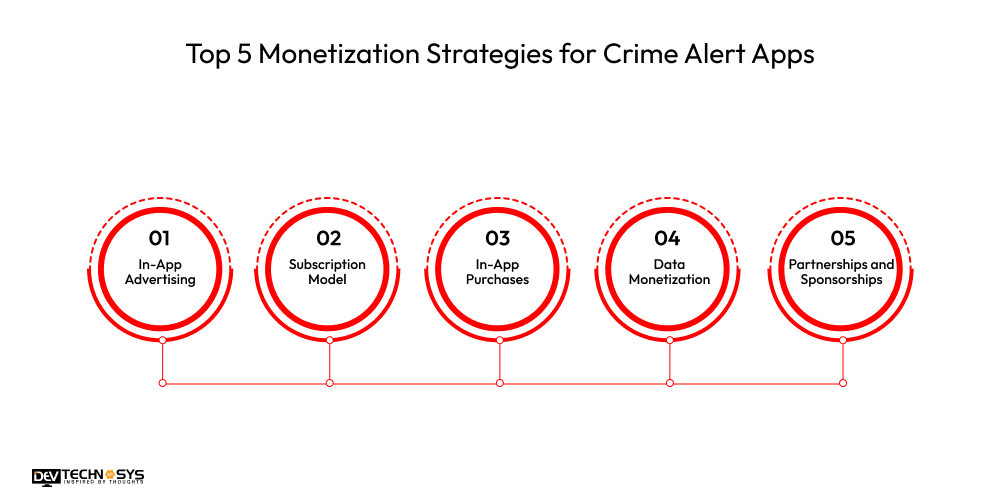
1. In-App Advertising:
This model involves displaying advertisements within the app to users. Revenue is created based on impressions, clicks (when a user taps an ad), or actions (when a user completes an action, like an installation or sign-up).
Formats of advertising includes banner ads, interstitial ads, ads of reward videos, and native promotions. Hire dedicated developers from reliable companies to implement these strategies.
2. Subscription Model:
This model of generating revenue deals with charging a small fee monthly or annually in order to use premium features, content, or an ad-free experience.
This strategy delivers predictable income streams and facilitates user commitment by constantly offering value. It often includes tiered pricing (basic, premium, ultimate) or a freemium approach (basic features free, advanced features paid).
3. In-App Purchases:
Users make one-time payments for digital goods, services, or features within the app. These purchases include consumables, non-consumables, or non-renewing subscriptions. While less common for the core “alert” function, IAPs could be used for:
- Unlocking unique themes or customization options.
- One-time access to a detailed crime report for a specific address.
- “Boosts” for alerts to specific community groups (if such a feature exists).
- Access to premium safety guides or courses.
4. Data Monetization:
Crime alert apps collect highly valuable data on incident locations, times, types, and user activity patterns. This data, when properly anonymized and aggregated (ensuring user privacy and adherence to regulatory laws and guidelines like GDPR or India’s DPDP Act), can provide significant insights for:
- Urban planning and public safety initiatives.
- Insurance companies assess risk in certain areas.
- Real estate firms provide neighborhood safety profiles.
- Retailers or service providers understand local market dynamics.
5. Partnerships and Sponsorships:
This model involves collaborating with other businesses or organizations who pay to associate with your app, leveraging its user base for brand exposure, lead generation, or integration of their services:
- Applicability to Crime Alert Apps: This is a strong potential revenue stream:
- Security Companies: Partner with local home security providers, private patrol services, or alarm system installers.
- Insurance Providers: Collaborate with home or auto insurance companies, offering discounts for users in certain areas.
- Local Businesses: Feature sponsored content or offers from local businesses within safe zones.
Conclusion
The above provided details and information discusses crime alert app development. Through this blog, we tried to provide informative insights about the Crime alert applications, why they are necessary. We also explored their types, features, reviewed the development steps, learned about the cost factors, and more.
Hopefully, the above given content clears any query or doubt you might have regarding crime alert app development. And, if you’re a business or NGo, wanting crime alert app development services, then hire mobile app developers from Dev Technosys. And stay tuned for more informative updates.
FAQs
1. What Does a Crime Alert App Do?
It notifies users about real-time crimes or safety threats in their area. Users can also report suspicious activity, helping keep communities informed and safe.
2. How Much Does it Cost to Build One?
The average cost of developing a crime alert application ranges from $8,000 to $30,000, depending on app complexity, platform (Android/iOS), and custom feature sets like AR or heatmaps.
3. Which Features Should I Include?
Start with real-time alerts, incident reporting, geofencing, SOS button, and community chat. Add-ons like AR navigation or crime trend analytics boost functionality.
4. How Long Does Development Take?
Expect a timeline of 12 to 24 weeks. Simpler apps may take 2–3 months, while feature-rich versions can go up to 6 months.
5. Can it Work For Both Android and iOS?
Yes! Cross-platform frameworks like Flutter or React Native allow you to launch on both platforms with a single codebase, saving time and money.
